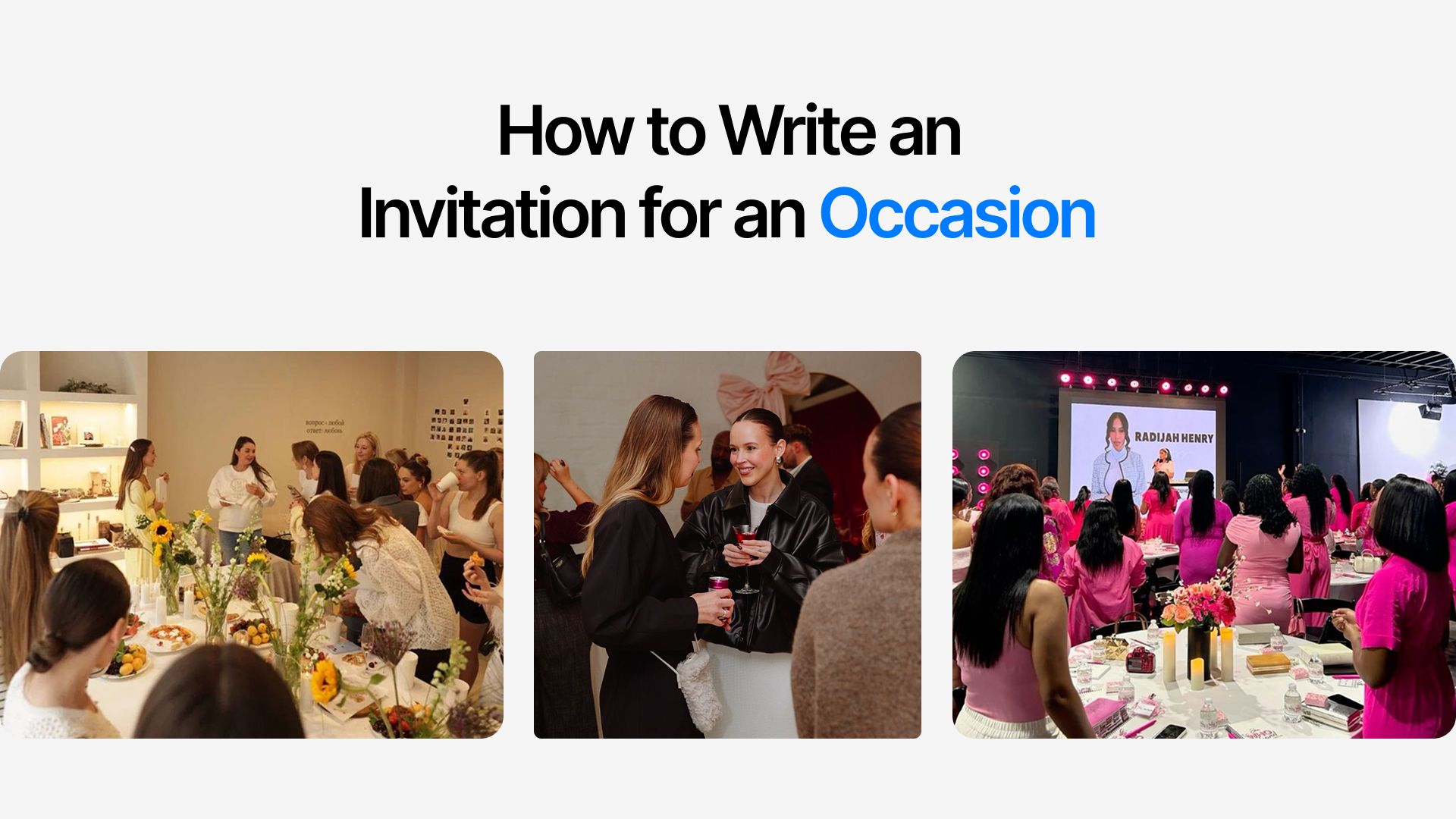
How to Write an Invitation for an Occasion
An invitation is more than a notice on paper or screen. It sets the mood for the event, explains the purpose, and helps guests prepare in advance. Strong wording can elevate even a simple gathering.
This guide covers the steps, tone, and details needed to write invitations that are both practical and memorable.
Understanding the Purpose of an Invitation
An invitation does not exist just to announce a date and time. It communicates the importance of the event, signals its formality, and encourages attendance. A well-crafted invitation provides clarity, while also creating a sense of anticipation for what is to come.
Step 1: Identify the Occasion
Every event carries its own atmosphere. The type of occasion determines the voice of your invitation. A wedding calls for respectful and elegant language. A birthday invitation can use lighthearted expressions. Corporate events should highlight professionalism and purpose.
Keep these in mind:
-
Weddings and engagements require warmth, gratitude, and formality.
-
Birthdays and casual gatherings can adopt humor or playfulness.
-
Corporate events and ceremonies benefit from a concise, professional tone.
Selecting the right approach ensures guests know how to prepare and what to expect.
Step 2: Choose the Right Format
The way you deliver an invitation matters almost as much as the words inside it. Printed cards carry elegance and permanence, making them ideal for weddings or formal banquets.
Digital invitations work well for casual or professional events that need quick responses. Email is common in business settings, where tone and clarity are more valued than decorative style.
Social media announcements add reach and can help informal gatherings spread quickly.
Pick the format that matches the event’s tone. A personal celebration often benefits from design and physical presence, while a work seminar may lean on efficiency through email. The format should reflect the importance of the occasion and the expectations of the guests.
Step 3: Structure the Core Details
Every invitation must include a set of essentials. Missing even one can confuse guests and reduce turnout. Think of these as the backbone of your writing.
Core details to include:
-
Host’s name so the recipient knows who is inviting them.
-
Purpose of the event to set context, such as a birthday, seminar, or retirement party.
-
Date and time written in full to avoid ambiguity.
-
Venue or platform with complete address or online link.
-
RSVP instructions explaining how and when guests should confirm.
Clear presentation of these details ensures that the reader spends less time guessing and more time preparing. Keep sentences straightforward, and make sure the layout is easy to scan.
Step 4: Set the Tone and Style
The language of an invitation shapes how people perceive the event before it begins. Formal ceremonies require respectful phrasing and complete sentences. Informal gatherings allow for lighter words that feel more conversational. Corporate events should remain polished but avoid being too stiff.
Examples:
-
A wedding card might say, “You are cordially invited to celebrate the union of…”
-
A birthday invitation could read, “Join us for a night of fun, cake, and music as we celebrate…”
-
A business seminar might open with, “We invite you to attend an exclusive session on…”
Matching tone with occasion prevents confusion and builds the right expectation in the reader’s mind.
Step 5: Add Personal Touches
Invitations that include unique elements feel warmer and more memorable. Cultural symbols, favorite quotes, or short poems can give personality to an otherwise standard format.
Hosts sometimes use themed colors or icons to reflect the spirit of the event.
Ways to personalize:
-
Add a line that reflects the relationship with the guest.
-
Use imagery or motifs connected to the event’s theme.
-
Include a short verse, lyric, or saying that captures the mood.
Personal touches transform an invitation from a notice into a keepsake. They also help guests feel that their presence truly matters.
Step 6: Review for Clarity and Accuracy
A strong invitation loses its impact if it carries errors. Every detail must be double-checked before sending. Dates and times should be confirmed, addresses verified, and RSVP instructions tested.
Even a single mistake can confuse guests or cause them to miss the event entirely.
Reading the invitation aloud helps catch awkward phrasing. Asking a trusted friend to review can highlight errors you may overlook. Clear language with correct information ensures the invitation fulfills its purpose.
Common Mistakes One Should Avoid
Certain errors appear often and can easily be prevented. Avoiding them makes the difference between a polished message and one that feels rushed.
Mistakes to watch for:
-
Forgetting to include RSVP instructions or deadlines.
-
Using overly complicated or flowery language that hides the core details.
-
Adding too much information, which makes the design cluttered.
-
Choosing a tone that does not match the occasion.
-
Skipping a review, leading to typos or incorrect details.
Addressing these points keeps the invitation professional and easy to follow. Guests appreciate accuracy and clarity, no matter the style of the event.
Sample Invitation Formats for an Occasion
Examples help when words don’t come easy. These formats show how to word an invitation for different occasions, using common styles in Europe and Australia.
-
Wedding Invitation Example
Together with their families
Charlotte Davies & Oliver Bennett
invite you to celebrate their marriage
on Saturday, 12th July 2025
at St. Mary’s Church, Oxford, England
Followed by a reception at Blenheim Palace
Kindly RSVP by 1st June 2025.
This version combines tradition with formality, which suits most UK and EU weddings. The mention of RSVP keeps it practical and polite.
-
Birthday Party Invitation Example
It’s time to celebrate!
Please join us for Amelia Brown’s 30th Birthday
on Saturday, 15th March 2025
at Bondi Pavilion, Sydney, Australia
Drinks and live music from 7:00 PM.
Shorter lines and a casual tone make this format better for personal events. Adding location detail like “Bondi Pavilion” adds character and clarity.
-
Corporate Event Invitation Example
TechNova Europe warmly invites you to the official launch of our new sustainability platform.
Date: Thursday, 23rd October 2025
Venue: Grand Hotel Wien, Vienna, Austria
Time: 6:00 PM – 9:00 PM
Cocktails and networking to follow.
This format reflects the professional tone expected in business circles. Clear details, followed by a social note, show attention to both formality and hospitality.
-
Informal Gathering Invitation Example
Let’s catch up over a relaxed dinner.
Join us at Marco’s Trattoria, Milan
on Friday, 28th February 2025
from 8:00 PM onwards.
This simple structure works for casual dinners, family get-togethers, or informal reunions.
How Chatly Can Help In Brainstorming and Invitation for an Event
Writing invitations can feel repetitive, especially when you are drafting for multiple events. Chatly AI Chat offers practical support by generating polished drafts that already include the right structure and tone.
Instead of staring at a blank page, you start with a complete template that only needs slight adjustments.
Chatly can assist with:
-
Suggesting wording that matches formal or informal events.
-
Creating sample invitations with complete structure including date, time, and RSVP sections.
-
Offering variations so hosts can choose between styles.
-
Checking tone consistency to ensure the message reflects the occasion.
Using Chatly saves time while keeping your invitations professional. It helps you focus on personal touches rather than building the full text from scratch. You can also ask AI to search and find you newer examples and uses.
Conclusion
An invitation is more than a formality. It carries the weight of the event’s first impression and communicates respect for the guests. Clear structure, accurate details, and a tone that matches the occasion create an effective invitation.
Adding small personal touches makes it memorable, and reviewing before sending ensures no detail is missed.
Invitations should always reflect the value of the moment they represent. When written well, they not only inform but also honor the presence of each guest.
Suggested Reads
Frequently Asked Questions
Most asked questions related crafting invitations.
More topics you may like

How to Write a 2-Week Resignation Letter

Muhammad Bin Habib

How to Write a Brand Collaboration Proposal in 2025

Muhammad Bin Habib

How to Write a Bulk Sales Request to a Buyer

Muhammad Bin Habib

How to Write a Book with No Experience

Muhammad Bin Habib

11 Best ChatGPT Alternatives (Free & Paid) to Try in 2025 – Compare Top AI Chat Tools

Muhammad Bin Habib
